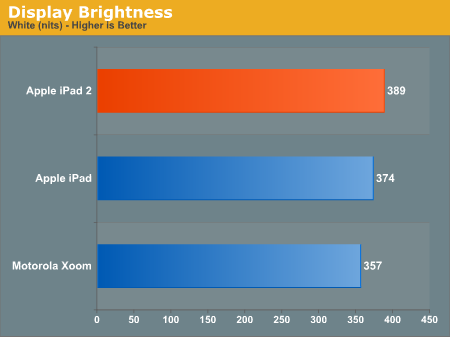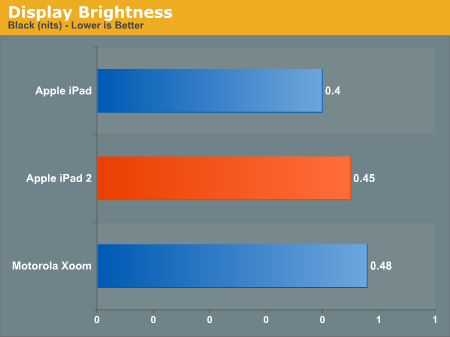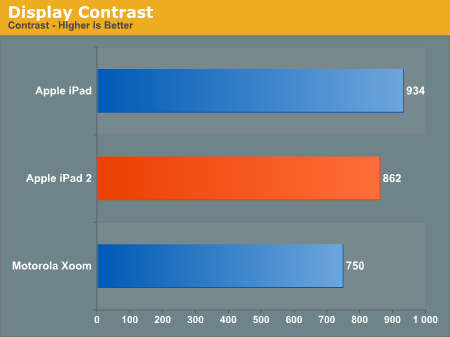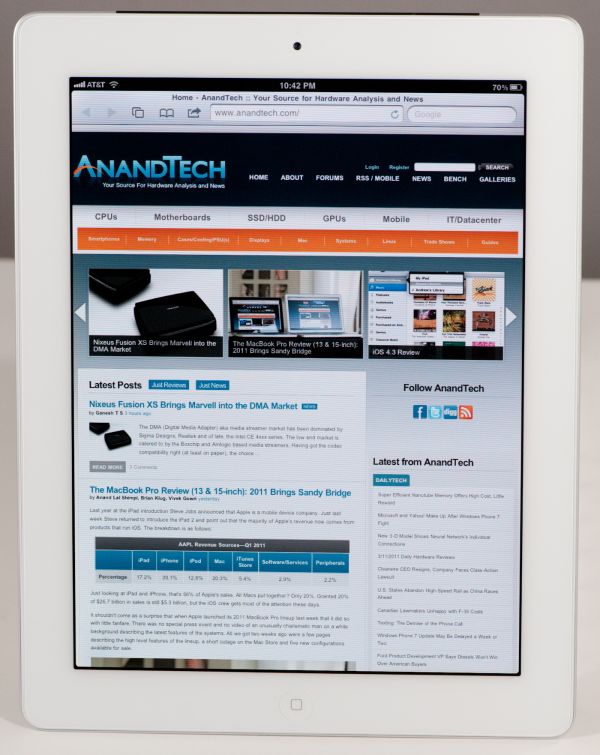Apple iPad 2 Preview
by Anand Lal Shimpi, Brian Klug & Vivek Gowri on March 12, 2011 6:01 AM ESTThe Display: Multiple Vendors, Nearly Identical to iPad 1
Apple built the iPad 2 with a similar 9.7-inch 1024 x 768 IPS panel as the original iPad. Side by side the two panels appear to have similar qualities in terms of brightness, black level and contrast ratio. Once we started measuring however we noticed a trend: there appear to be multiple panel vendors in play here.
Between Brian, Vivek, Manveer and myself we have four iPad 2s. Brian and I have two 3G models (AT&T and Verizon), while Vivek and Manveer have two WiFi models. All four are white and all four have 16GB of NAND. The results from our baseline display testing are below:
| Display Quality Comparison | |||||
| White Level | Black Level | Contrast Ratio | |||
| Apple iPad 2 #1 (AT&T 3G) | 406 nits | 0.42 nits | 966:1 | ||
| Apple iPad 2 #2 (VZW 3G) | 409 nits | 0.49 nits | 842:1 | ||
| Apple iPad 2 #3 (WiFi) | 352 nits | 0.45 nits | 778:1 | ||
| Apple iPad 2 #4 (WiFi) | 354 nits | 0.41 nits | 859:1 | ||
There seem to be two different values for white level: either around 400 nits or 350 nits. Black level is pretty variable between 0.41 nits and 0.49 nits, there doesn't seem to be a correlation between white and black levels in our admittedly limited sample size. For our display graphs we simply averaged all four together:



On average the iPad 2 seems to be marginally brighter with a bit worse black levels than the original iPad, resulting in a lower contrast ratio. The display is pretty close to what was in the original iPad and very tough to tell apart. There's still a visible advantage in contrast ratio over the Motorola Xoom.











82 Comments
View All Comments
erple2 - Tuesday, March 15, 2011 - link
In the iOS case - they're synonymous. You can't get the "new" browser without also getting the new OS update.tipoo - Saturday, March 12, 2011 - link
In addition to software differences, each company also tweaks the design of the Cortex A9 to their liking. After ARM licences it out they can do pretty much whatever to it. So you might see Qualcomm adding cache, Nvidia doubling the bus, or whatever.metafor - Tuesday, March 15, 2011 - link
ARM core licenses do not allow you to modify the CPU design. ARM allows different options when configuring cache size and bus width and co-processors but only with their macro-generator. There's definitely flexibility, but it's not "whatever you want". There are limited flavors if you will of yummy goodness.Anand Lal Shimpi - Saturday, March 12, 2011 - link
While the underlying architecture between those devices may be similar, there are some differences. For example NVIDIA's Tegra 2 only has a single channel 32-bit LPDDR2 memory interface while TI's OMAP 4 has a dual-channel LPDDR2 memory interface.Tegra 2 also lacks an MPE (SIMD engine) while the OMAP 4 doesn't.
Take care,
Anand
tipoo - Saturday, March 12, 2011 - link
I'd be interested in a comparison between all these mobile processors. I understand its difficult since the iPad uses a different OS, but given the numbers where do you think it stands compared to Tegra 2 and the like?zhill - Saturday, March 12, 2011 - link
My understanding is that the ARM Cortex A9 is just an instruction set and architecture specification/chip design. Each company manufactures the actual chips themselves so they can make additional changes at the hardware level such as lithography, voltage, clock frequency, cache sizes etc. So they license the design from ARM, but build the silicon themselves so each design may vary in terms of actual implementation and performance.Software also certainly makes a difference.
winterspan - Saturday, March 12, 2011 - link
you are right to an extent. There are actually two different licenses, a manufacturing license and a "design" license. Basically, if you pay more for the design license, they can make a custom core that implements the ARM Cortex v7 instruction set. This is what Qualcomm does with their Snapdragon. Most of the other guys just have the manufacturing license and this enables mild adjustments, but essentially they all have to use a similar Cortex-A9 core.Not sure what the Apple cores are... Standard Cortex-A9 or something more custom from Intrinsity/Samsung?
jmmx - Sunday, March 13, 2011 - link
"If Apple iPAD 2, NVIDIA's Tegra 2, TI's OMAP 4 and Samsung's Exynos all use the same Dual Core ARM Cortex A9…"There is more to it than this. The simple fact is they do NOT "use the same Cortex A9." They each user their own implementation of the A9. Additionally, A9 is the core cpu design, but the chips are SoC chips "System on a Chip" That is, they contain a lot more than just the A9 CPU but other non CPU functional units as well.The configuration of these units can significantly affect performance.
This is my understanding of the situation. (Caveat - I am a software engineer not hardware.) Someone out there feel free to correct me if I am mistaken about this.
str1ke007 - Saturday, March 12, 2011 - link
Can the ipad2 be tetherd to an iphone ?? (so i can use the 3G data i allready pay for rather then paying for another sim/plan)kmmatney - Saturday, March 12, 2011 - link
There is no reason why you couldn't, and this is what I plan on doing. However I would like to know if the map and GPS apps work well on an iPad without 3G. Do you need to get a 3G for the GPS to work properly?